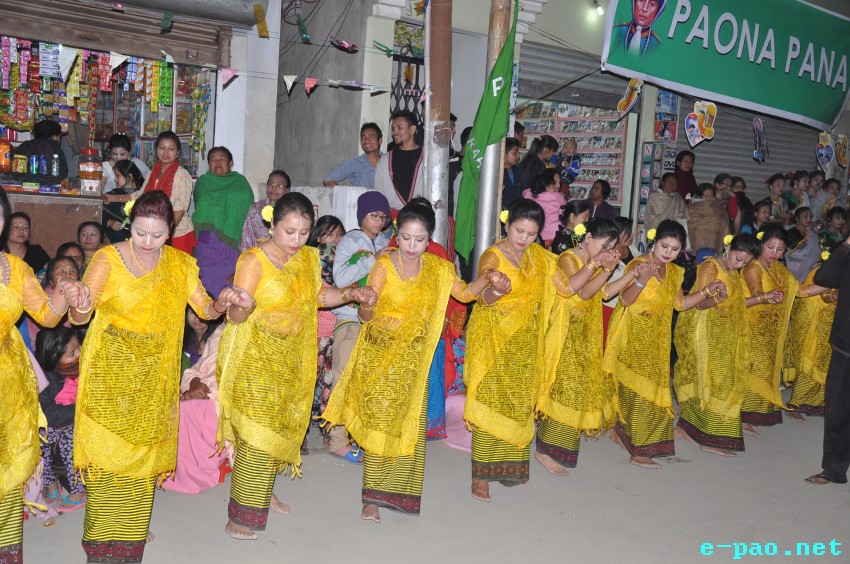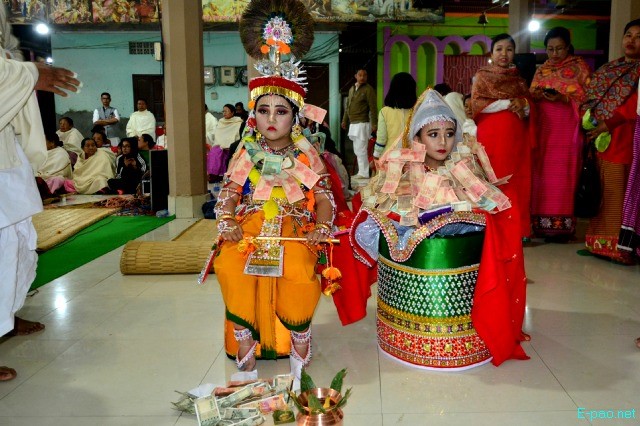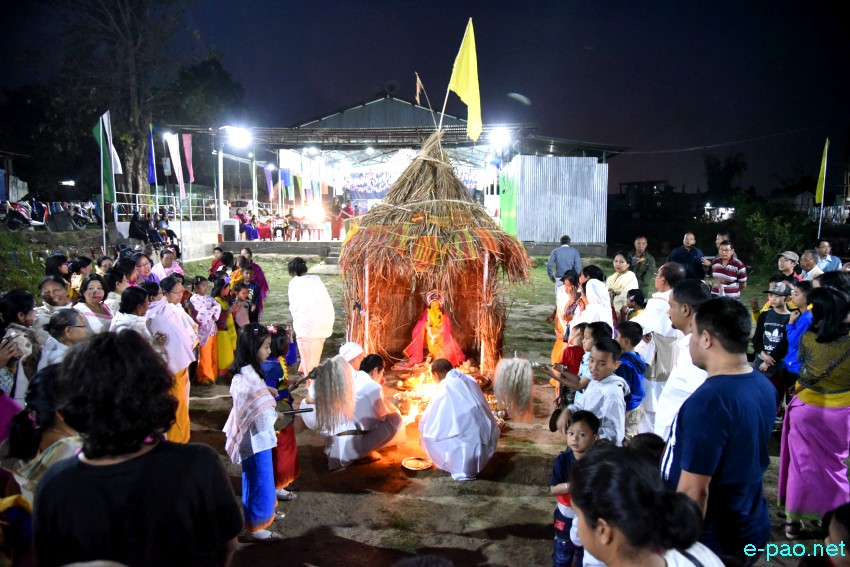The future Hindu Culture of Meitei remains magificient
The Culture of Krishna is growing world-wide
Dr Irengbam Mohendra Singh *

Increasing adult patronage of Thabalchongba (Hindu culture: Krishna & Gopi dancing)
Yaoshang Thabal Chongba Competition at YCB (Youth Club Brahmapur) on 7th March 2015 :: Pix - Lamdamba Oinam
It has been a joy and a privilege that I was born a Hindu and have been accepted as a genuine Indian all over India during my whole life. A Muslim or a Christian was looked upon as a kind of 'foreigner' or half-Indian by the majority of Indians, who are Hindus (80 %). The percentage, however, has dropped to 78.8% (2014), as the Muslim population has marginally increased to 14.2 % because of the increasing fertility rates (not using birth control measures). The Christian population remains static at 2.3%.
In light of these statistics, I had a look at the articles by Prof RK Narendra (e-Pao net, Saturday, May 18 2019 and Sunday, May 19 2019 - Link here and here ) about the decline of Hinduism in Manipur, and his heartfelt, virtuosic and quietly thoughtful explorative statistics. It is indeed very impressive. He seems to have qualms of "such drastic demographic transition," echoing his worries like "Hinduism is reducing faster and eventually Hindu is no more majority group and Christianity becomes the majority community in the state after the 2011 census.
I would like to assuage the morbid feelings of Prof Narendra that all is not lost. Hinduism is still the majority religion in Manipur and will remain so in the future. Looking at his analytical data, the professor's worries are justified. But statistics are notoriously unreliable. The graphs can be bent upwards, downwards or straight. One British Prime Minister Benjamin Disraeli once said, there are three lies: lies, damn lies and statistics. The popularity of this quotation remains unchanged as one still always bend the statistics at will
This is because statistics have many pitfalls. They have things like Standard error and Margin of error. Collecting a census depends on how many respondents have a high degree of confidence, and the decline in response rate although it is obligatory on the part of every citizen. Imagine how many people in the villages of Manipur would bother to answer such questions, forgetting those who have never received such a questionnaire by post or in person.
The success rate of accuracy also depends on the census officers' discharge of their duties faithfully. Besides, many respondents if they respond at all, may give false replies because of certain fears or doubts despite it being illegal. Some communities in Manipur have a tendency to give fake population growth (Christians), such as the one from Senapati district in the 2011 census.
There are other loopholes in Indian national statistics, such as the ex-President of India, KR Narayanan was unable to register his sub caste, which may alter the data .Even in civilised countries like the UK, the Census Bureau reports statistics at 90% 'confidence level'.
In the case of religious demographic pattern in Manipur there are many variables to be accounted for, such as Hindu Meiteis who also believe in the traditional preliterate religion of the Meiteis. I wonder how they will respond! They might not be just bothered.
On the other hand, Christians in the Hills will be more than happy to respond as they would like to see the population of Manipur to be completely Christianised. The majority of converts are to Sanamahism and they account for only 2.2 lakhs. In spite of the soft proselytisation by Kerala Christian Catholic missionaries, who are funded from overseas, for establishing many Christian schools in the valley for the purpose, Christian converts among the Hindu Meiteis are only miniscule.
It began among some poor Meiteis living near the Christian hill tracts, such as Bishnupur. It was the Catholic Jesuit priests who realised that the best way to convert natives is through general education while imparting the message of Christ through the four Gospel writers.
For me, they are welcome, as everyone is free to practice the religion of his or her choice. No sweat. It won't be anything like the professor puts it - an Armageddon: "It will cause social disorder and chaos that becomes difficult to maintain peace and harmony amongst people in the state."
The professor's graph shows an acute decline in Hinduism in Manipur from 60% in 1951 to 41% in 2011, while Christianity has almost levelled up. Christianity will rise in the hills as the old people who believed in their ancestral religions are dying out and being replaced by young people who are gradually initiated to Christianity. There is only a small number of Meiteis who have become Christians, not because Christ is a better saviour than Krishna, but because of social and economic exigencies.
In opposition to the professor's prediction of doom and gloom about the attenuation of Hinduism in Manipur to 0% in the near future, I would like to assuage his nuances by my forecast that, the census of 2021 will find Hinduism quite alive and growing. If the statistics show a decline, it is due to educated Meiteis reducing their birth rates.
Though I am not a Krishna-Bhakta or a follower of Christ, I am going to write a short precis why changing religion is meaningless for the functionally educated people, while stressing more on the Yaoshang festival and the origin of Hinduism, to validate that Hinduism in Manipur remains magnificent, and they are growing though many youngsters are non-practising Hindus.

Increasing celebration of Krishna Leela as it was during my childhood
From the empirical evidence I have collected, I see the future of Hinduism in Manipur will grow and grow. Let's look at the growing and exuberant Krishna Leela, Yaoshang celebration or Holi revellers, and Kangchingba, in Manipur. A great part of enjoyment of a religion is in its rituals of celebrations, such as the saroi khangba and Lai harouba of the preliterate religion of the Meitei, which are an everlasting glitch in Meitei psyche like a glue-stick-like contraption thinking.
I grew up as a Krishna-Bhakta as practised by my parents and the community. Prof Narendra's article brings back a nostalgic deja vous of the aesthetic pleasure of many Yaoshang festivities during my childhood and as a young adult.
Yaoshang with Thabalchongba stands aloof in the dream house of every Meitei adult. Wherever Meiteis diaspora are globally, there is always thabalchongba to reminisce their youth. This is one of the best symbols of Hinduism, which is growing among the Meiteis. You won't expect a Sanamahist or a Christian to be taking part in Yaoshang festivals, but they do, at least in thabalchongba. The Sanamahists are accepted by the majority Hindus, who are half-Sanamahists, like the Japanese who profess Buddhism and ancient Shinto religion.
The culture of Yaoshang celebration is here to stay for eternity, like the Radha-Krishna inspired dance performance of Ras Leela, known as Manipuri dance. This is Hinduism. The cult of Krishna ie bhakti – a selfless devotion to him, is also here to flourish, whether it is mythology, legend or fable. It is 200 years old and still not beat. Holi (Yaoshang in Manipur) is a Hindu festival celebrated all over India and wherever Hindus, especially Krishna worshippers live. It is now all the more invigorated by the ISKON all over the world.

More enthused Yaoshang Meithaba
Yaoshang Mei Thaba : Offerings and Prayers to God and burning of Yaoshang Hut on March 21 2019 :: Pix - Lamdamba Oinam
Yaoshang (Holi) is celebrated for the arrival of spring. It's like the Kuki Kut Festival to celebrate the end of harvest season or the Naga Lui-Ngai-Ni to celebrate the seed sowing. It is celebrated all over India for 2 days with a bonfire on the first night but, in Brindaban and Mathura it lasts 16 days, beginning about a week before. The tradition of throwing coloured powder and water is believed to have originated from the mythological love story of Krishna and Radha.
Krishna of dark complexion, aesthetically described as blue (Krsna in Sanskrit, meaning black) is said to have complained to his mother about Radha's fair complexion, as in the popular Krishna bhajan:
Yasodaji meiyase bole Nanda lala,
mei kyon kala, Radha kyon gori.
The son of Nanda (name of Krishna's father) said to his mom,
why am I black and Radha is white?
To ease Krishna's disappointment, his mother suggested he smear Radha with colour paint. That was how smearing loved ones with colour during Holi came from.
Holi in Manipur took a Gothic turn as "Yaoshang", stymied by narratives that predate the existence of the missionaries of Chaitanya Bhakti movement, like the present day ISKON. They warped the tradition of Holi slightly, to make Chaitanya remembered as an incarnation of Krishna.
As we Meiteis know, Yaoshang is celebrated in the evening of the Full Moon day of the month of March (Sajibu/Lamta in Manipuri) every year. But here in Manipur, our ancestors were taught to celebrate it in conjunction with the birth day of Chaitanya, and in the Manipuri tradition.
The Meitei tradition has it that all Meitei women give birth to their babies in a special hut, known as Yaoshang that was built for the purpose and later, burnt as unholy. My father had a permanent small house built by the north side of our Yumjao. We were all born in it. And before the War, all my sister-in-laws gave birth to their babies in it.
In Manipur, on the first day of Yaoshang, each Leikai (small community) would build a straw hut. In my childhood, during the World War II, children of a small community would spend nights together at a house, for about a month. We would have had a small saw made out of a steel blade. With that, in the thick of night, we would roam quietly and saw off bamboos that was easily accessible from our daytime recce at the back of an Ingkhol of a house in the neighbourhood. We would then pile them somewhere in a trench by the road for building that hut.
In the evening, a local Brahmin would bring the small idol of Chaitanya (not Krishna) and place it inside the hut as a symbolism of his birth. After the usual puja ritual, the idol would be moved back to where it came from. Then the adult worshippers and children would set the hut on fire as unholy in Meitei tradition. It's known as Yaoshang Meithaba. This would be followed by thabalchongba after a couple of hours.

Growing participation of the youth (unlike during my time)
Yaoshang Halankar celebration at Sagolband Bijoy Govinda on March 25 2019 :: Pix - Shankar Khangembam
Some Indian secularists believe that the festivals of Holi and Diwali have come down from the pre-Vedic tribal strands, related to the solar calendar. By this they mean these were events that were celebrated based on the progression caused by the sun through the seasons. Likewise, some secularists believe that Christmas celebration has borrowed the pagan Norse practice of a feast round a fire, singing carols, as a sign of the return of the Sun God. In the Netherlands, Christmas is celebrated on December 5 - St Nicholas's Eve. (Similar to Christmas Eve) when St Nicholas brings presents for children.
I love the idea of Christmas that Charles Dickens had promulgated. The essence of what he wrote in his novel, A Christmas Carol is that, it is the coming together of people around a table, the celebration of their humility, the sharing of the bounty, the reward of indulgence, even that is once a year. This is what Yaoshang does for Meiteis.
Like Jesus, the life of Krishna was unknown until the Mahabharata War (3,000 years BCE) when he told Arjun the philosophy of life, known as the Bhagavad Gita. He was in his mid- thirties like Jesus. There are hardly any facts about him. But there are legends and fables that may possibly be accounts of his historical origin and subsequent cults. Krishna was then the ruler of Dwarka, now a sunken city in the west coast of India, which archaeologically speaking, existed 4,000 years ago.
Gita is believed to be added to the Mahabharata in the 2nd century BCE. The text of Gita was put to the mouth of Krishna as he was not among the fighting heroes. He was only a charioteer. After the battle of Mahabharata, Krishna went back to Dwarka and reigned there for 36 years. He was accidentally shot dead by the arrow of a hunter.
It is believed that Krishna is an indigenous hero, who the fair-complexioned Aryans incorporated in the Mahabharata. Since then the cult of Krishna remains undiluted, as in the celebration of Holi. While searching for written materials to write a book on the existence or otherwise of God, I looked at the origin of Hinduism and Krishna's relevance in it to see if it breaks new ground in the arid gaps of Krishna's life story. The following is an excerpt from my dissertation.
India as we know, is Bharat. During the Mughal period it was also known as Hindustan. Indian civilisation, taking cue from the excavations of the cities of Mohenjo-Daro and Harappa was dated as old as that of Egypt, Persia and Mesopotamia during my school days, according to Sir John Marshall, the author of the Indus valley civilisation. Archaeologist Gordon Childe thought that the Indus valley civilisation (IVC) that is estimated to be 5-6 thousand years old was probably destroyed by the flood of the Indus River.
I mention the IVC in the context that some artefacts resembling "Shiv Lingam", the south Indian god was discovered during the excavations, leading to the belief that the civilisation may have been related to the Dravidian races. While there is a definite sense of continuity between the Indus valley civilisation and the later periods, there are also certain breaks not only in the point of time but also in the kind of civilisation that followed which was initially a more agrarian civilisation. That civilisation was brought about by Aryans who poured into India in successive waves from the northwest.
The Aryan migration supposedly took place about a thousand years after the Indus valley civilisation. Gradually, over a matter of years, these Aryan tribes became assimilated in India. From the synthesis of these foreign Aryans, and indigenous Dravidians who were probably the representatives of the Indus valley civilisation, grew the Indian races and Indian culture. In the ages that followed, there came many races to India and were absorbed in India in turn.
The word "Hindu" does not occur at all in ancient Indian literature. The first reference to it is in an Indian book – a 'Tantric' work in the 8th century BCE, where Hindu means people and not the followers of a particular religion. The word Hindu is derived from "Sindhu" – the Indian name for Indus for the Persians who called Sindhu River as Hindu River (S is pronounced H in Persian language. The use of the word Hindu in connection with Hindu Religion is of a very late occurrence.
The word dharma means more than a religion. It is from a root Sanskrit word - 'dhar', which means 'to hold together'. The Vedas were outpourings of the Aryans as they streamed to India (Pundit Nehru, The Discovery of India). Max Muller called it – the first words spoken by Aryan men. To Hindus, the Vedas are revealed scriptures like the Bible or the Quran. They are a jumble of many things such as hymns, prayers, rituals for sacrifice, magic poetry, mythology and medicinal practice.
There were no temples of gods or idols. The early Vedic Aryans had no idea of the soul though they vaguely believed in some kind of a god and existence after death, like all primitive people do. They saw god's presence in nature on Earth. They worshipped the sun, moon, sky, mountains, rivers, rain, animals and plants. They venerated the Tulsi plant (Indian balsam) as deity Lakshmi, for its medicinal values.
Gradually the conception of god grew over the course of hundreds of years. The last of the Vedas, the Vedanta, composed in 800 BCE, contains the Vedic philosophy or Upanishads. This is what's known as Eastern philosophy. In the post-Vedic era, called the Puranic era, the gods began to assume certain forms and individual characters.
In the late Puranic period when the epics of Ramayana and Mahabharata were compiled, the Vedic gods became more prominent. The concept of Tinmurti (three figures) emerged. This is the present Hindu Trinity consisting of Brahma, Vishnu and Mahesh, similar to the Christian Trinity of Father, son and Holy Spirit – parts of a supreme Godhead.
The historical dimensions of Krishna as a person or a god are diverse and complicated. So are the accounts of Jesus. Yet, the life story of Krishna is simply poetry to Hindus. Let's just enjoy Yaoshang thabalchongba.
* Dr Irengbam Mohendra Singh wrote this article for e-pao.net
The writer can be contacted at irengbammsingh(AT)gmail(DOT)com and Website: www.drimsingh.co.uk
This article was webcasted on May 22, 2019. .
* Comments posted by users in this discussion thread and other parts of this site are opinions of the individuals posting them (whose user ID is displayed alongside) and not the views of e-pao.net. We strongly recommend that users exercise responsibility, sensitivity and caution over language while writing your opinions which will be seen and read by other users. Please read a complete Guideline on using comments on this website.








